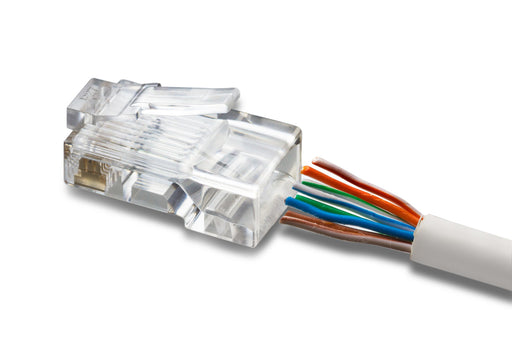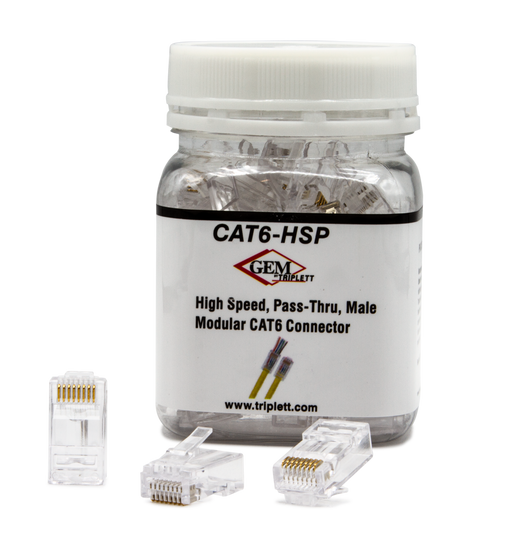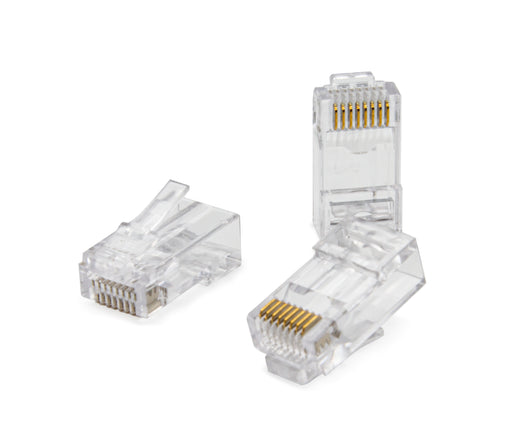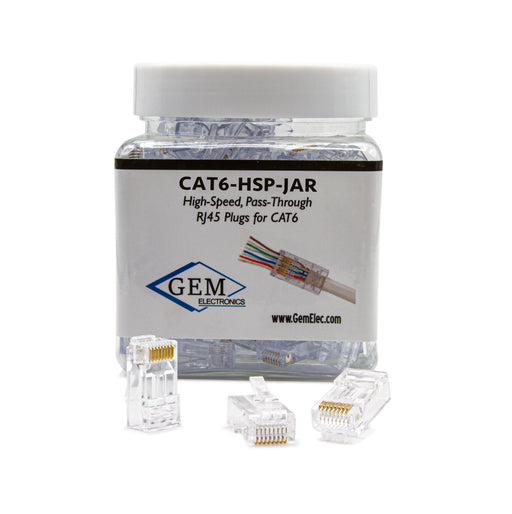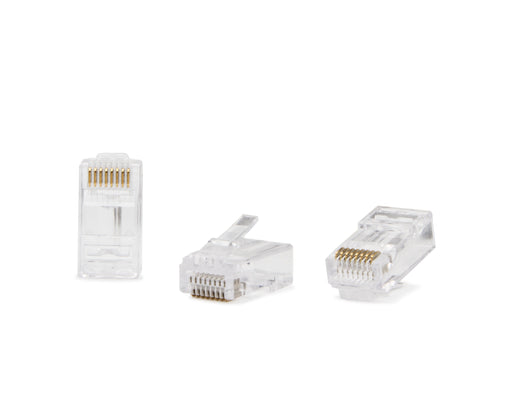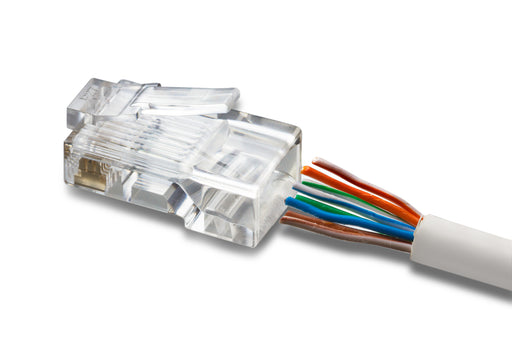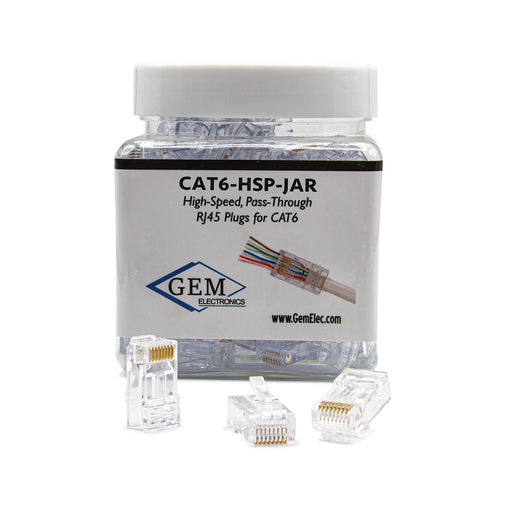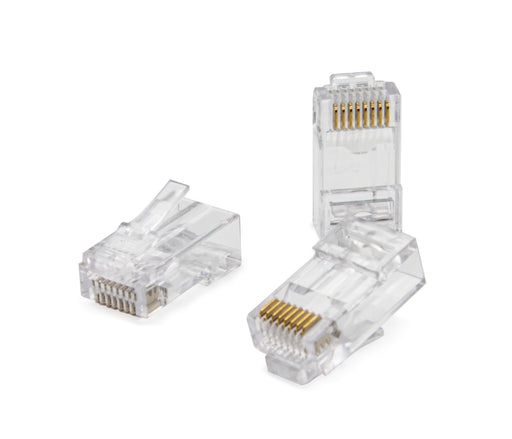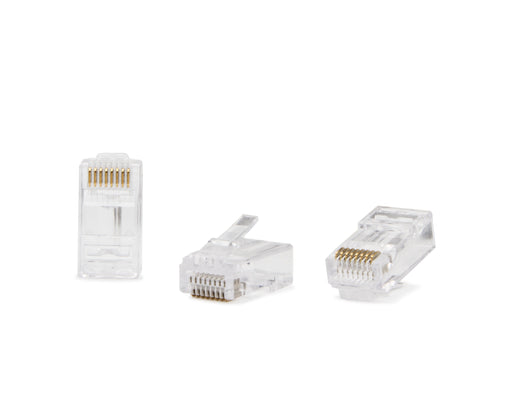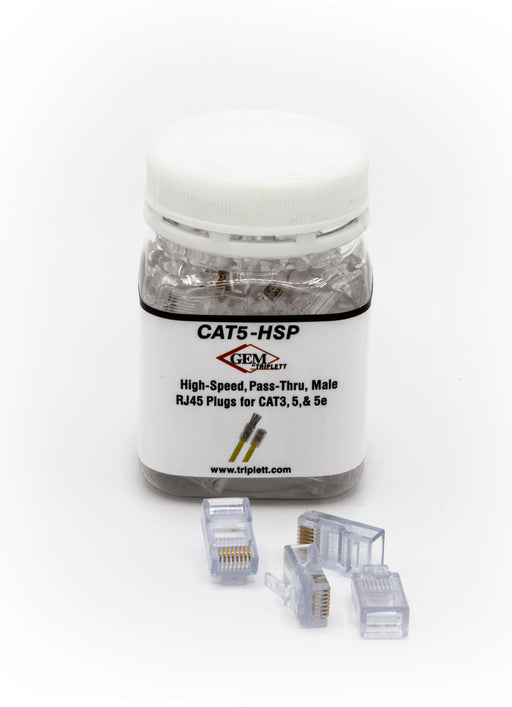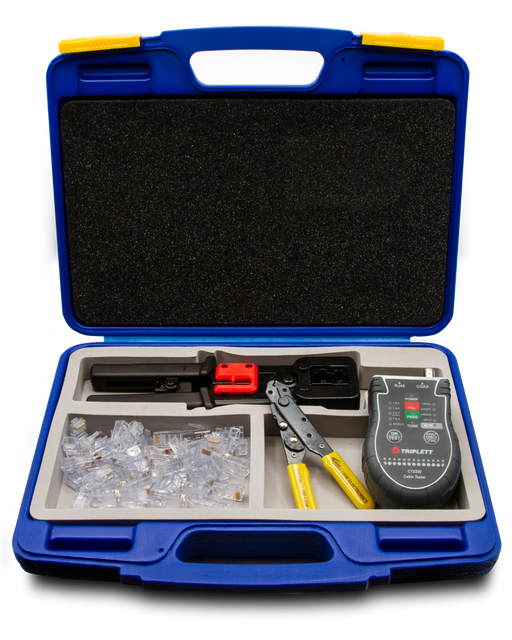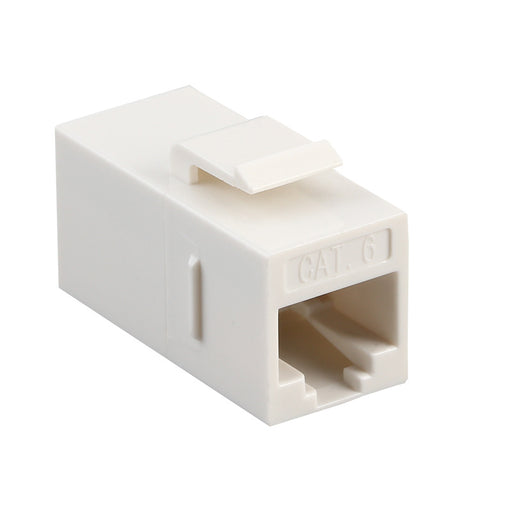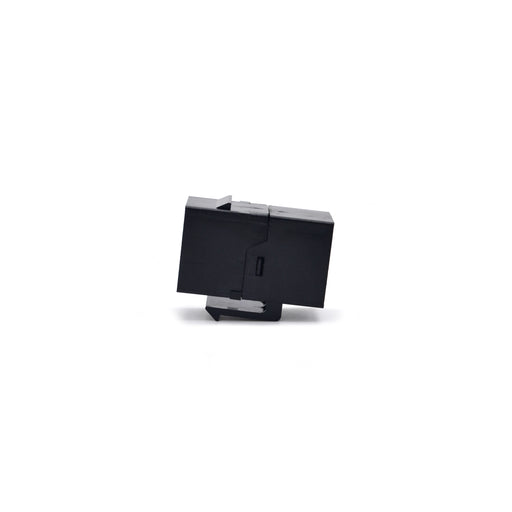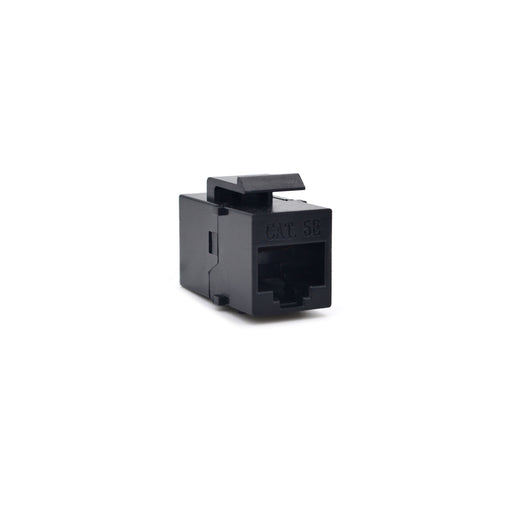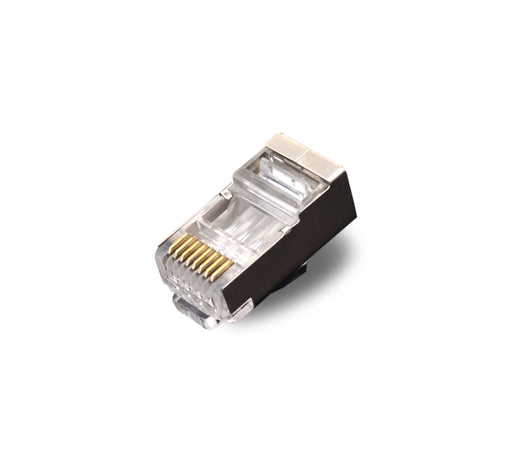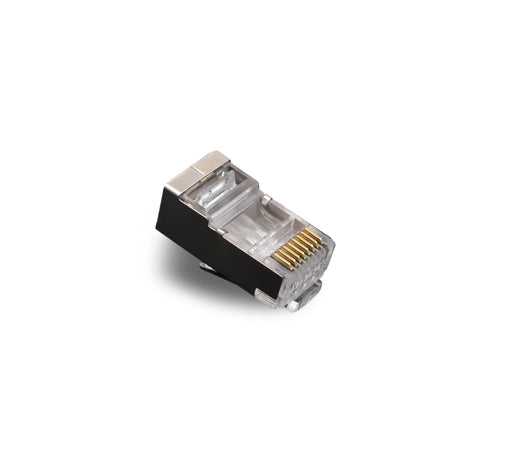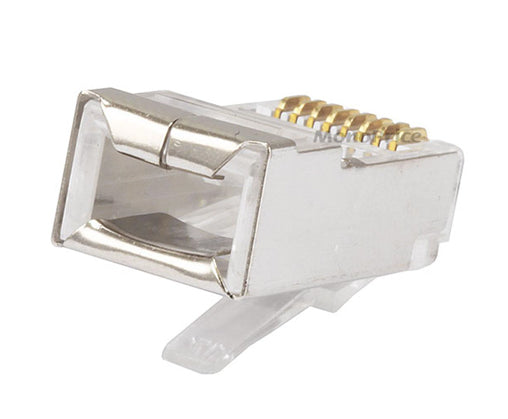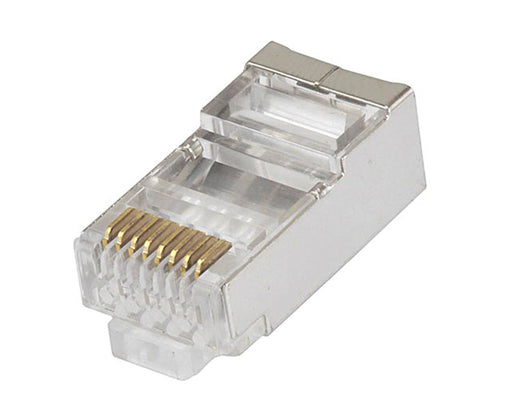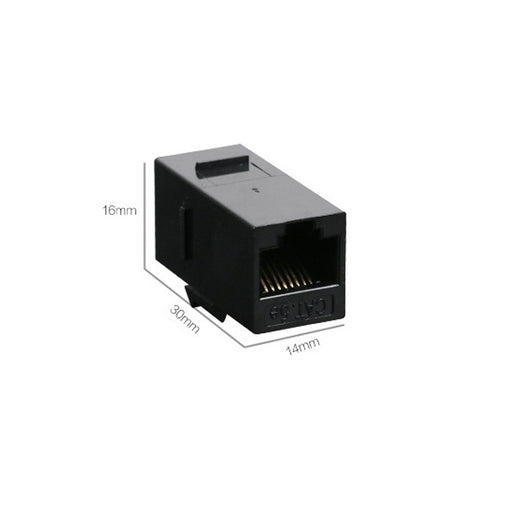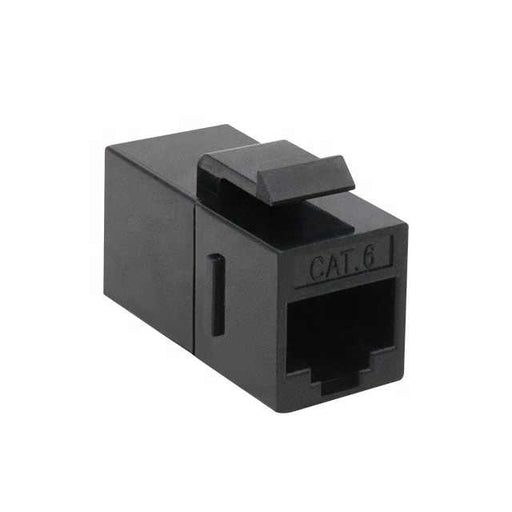
CAT5 & CAT6 Connectors
Triplett provides these Ethernet cable connectors in various specifications. The performance of our network cable connectors is influenced by a twist, which helps minimize the crosstalk. Our Cat5 and Cat6 connectors use the RJ-45 plug to connect to their end destination, which can be either modem or a patch cable. Our high performance modular CAT5 connectors are suited for HD-TVI, AHD, CVI, and IP CCTV systems. There are 8 wire slots in the connectors that help keep the wires in the position. The connectors have a clear top that allows for pin-out inspection during crimping. To find the best LAN cable connector that fulfills your need, scroll through the selection list mentioned below.
Cat5 and Cat6 are the most popular and preferred Ethernet connectors. They can connect different devices within the network for seamless data transmission. Cat5 connectors support 100Base-T and 1000Base-T standards and frequencies up to 125MHz. Cat6 connectors are designed for high-speed applications of 10GBase-T.
Filters
-
50 PackOriginal price $27.49 - Original price $27.49Original price$27.49$27.49 - $27.49Current price $27.49| /
High Performance Modular CAT6 Connector - 50 Pack (CAT6-HPP)
GEM by TriplettIn stockHigh Performance Modular CAT5 Connector -- Male. (Not pass-through.) Bag of 50. Features Lead-ins molded into the inside of the cable entry gui...
View full detailsOriginal price $27.49 - Original price $27.49Original price$27.49$27.49 - $27.49Current price $27.49| / -
50 PackOriginal price $32.99 - Original price $32.99Original price$32.99$32.99 - $32.99Current price $32.99| /
CAT5/6 Connector, Male, 50 Pack - (CAT6-HSP)
GEM by TriplettIn stockHigh Speed, Pass-Thru, Modular CAT6 Connector -- Male. Bag of 50. Features Simplify twisted pair terminations by allowing the wires to slide t...
View full detailsOriginal price $32.99 - Original price $32.99Original price$32.99$32.99 - $32.99Current price $32.99| / -
Original price $60.49 - Original price $60.49Original price$60.49$60.49 - $60.49Current price $60.49| /
CAT5/6 Connector, Male, 100 Pack - (CAT6-HSPJAR)
GEM by TriplettIn stockHigh Speed, Pass-Thru, Modular CAT6 Connector -- Male. Bag of 100. Features Simplify twisted pair terminations by allowing the wires to slid...
View full detailsOriginal price $60.49 - Original price $60.49Original price$60.49$60.49 - $60.49Current price $60.49| / -
50 PackOriginal price $20.99 - Original price $20.99Original price$20.99$20.99 - $20.99Current price $20.99| /
CAT5/6 Connector, Male, 50 Pack - (CAT5-HPP)
GEM by TriplettOut of stockHigh Performance Modular CAT5 Connector -- Male. (Not pass-through) Bag of 50 Features Lead-ins molded into the inside of the cable entry g...
View full detailsOriginal price $20.99 - Original price $20.99Original price$20.99$20.99 - $20.99Current price $20.99| /Out of Stock -
50 PackBest SellerOriginal price $27.49 - Original price $27.49Original price$27.49$27.49 - $27.49Current price $27.49| /
CAT5/6 Connector, Male, 50 Pack - (CAT5-HSP)
GEM by TriplettIn stockHigh Speed, Pass-Thru, Modular CAT5 Connector -- Male. Bag of 50. Features Simplify twisted pair terminations by allowing the wires to slide ...
View full detailsOriginal price $27.49 - Original price $27.49Original price$27.49$27.49 - $27.49Current price $27.49| / -
Original price $54.99 - Original price $54.99Original price$54.99$54.99 - $54.99Current price $54.99| /
CAT5/6 Connector, Male, Jar of 100 - (CAT5-HSPJAR)
GEM by TriplettIn stockHigh Speed, Pass-Thru, Modular CAT5 Connector -- Male. Jar of 100 Features Simplify twisted pair terminations by allowing the wires to slide ...
View full detailsOriginal price $54.99 - Original price $54.99Original price$54.99$54.99 - $54.99Current price $54.99| / -
Original price $38.29 - Original price $38.29Original price$38.29$38.29 - $38.29Current price $38.29| /
Crimp Tool for CAT5-HPP and CAT6-HPP RJ45 Connectors - (GET-CAT5HPP)
GEM by TriplettOut of stockCrimp Tool for CAT5-HPP and CAT6-HPP RJ45 connectors CATEGORY: CCTV CRIMP TOOL Features For use with GEM High Performance Modular CAT5 and C...
View full detailsOriginal price $38.29 - Original price $38.29Original price$38.29$38.29 - $38.29Current price $38.29| /Out of Stock -
Best SellerOriginal price $69.29 - Original price $69.29Original price$69.29$69.29 - $69.29Current price $69.29| /
Crimp Tool for High-Speed, Pass-Thru RJ45 Connectors - (GET-HSCT)
TriplettIn stockCrimp Tool for High-Speed, Pass-Thru RJ45 connectors CATEGORY: CCTV CRIMP TOOL Features Works with GEM CAT5-HSP & CAT6-HSP plugs) Cut, ...
View full detailsOriginal price $69.29 - Original price $69.29Original price$69.29$69.29 - $69.29Current price $69.29| / -
Best SellerOriginal price $186.99 - Original price $186.99Original price$186.99$186.99 - $186.99Current price $186.99| /
High-Speed, Pass-Thru RJ45 Tool Kit - (HS-TK)
GEM by TriplettLow stockHigh-Speed, Pass-Thru RJ45 Tool Kit CATEGORY: CCTV CABLING HAND TOOLS Features includes HS-CT crimp tool, 50 CAT5-HSP connectors, wire cutte...
View full detailsOriginal price $186.99 - Original price $186.99Original price$186.99$186.99 - $186.99Current price $186.99| / -
Original price $2.63 - Original price $2.63Original price$2.63$2.63 - $2.63Current price $2.63| /
CAT6 RJ45 Inline Coupler - (CAT6-CPL-WH)
GEM by TriplettIn stockThe Triplett Model CAT6-CPL-WH is a CAT6 RJ45 inline coupler used to join 2 Ethernet cables together to create a longer cable. Simply plug cables i...
View full detailsOriginal price $2.63 - Original price $2.63Original price$2.63$2.63 - $2.63Current price $2.63| / -
Original price $2.63 - Original price $2.63Original price$2.63$2.63 - $2.63Current price $2.63| /
CAT5E Inline Coupler - (CAT5-CPL-BK)
GEM by TriplettIn stockThe Triplett Model CAT5-CPL-BK is a CAT5e RJ45 inline coupler used to join 2 Ethernet cables together to create a longer cable. Simply plug cables ...
View full detailsOriginal price $2.63 - Original price $2.63Original price$2.63$2.63 - $2.63Current price $2.63| / -
50 PackOriginal price $21.99 - Original price $21.99Original price$21.99$21.99 - $21.99Current price $21.99| /
High Performance Modular CAT6 Shielded Connector - Male, 100PK (CAT6-HPPS-HP)
GEM by TriplettOut of stockThe Triplett Model CAT6-HPPS-HP CAT6 3-prong, RJ45 clear modular connectors for FTP shielded cable feature 0.35mm thickness with 8 contacts/positio...
View full detailsOriginal price $21.99 - Original price $21.99Original price$21.99$21.99 - $21.99Current price $21.99| /Out of Stock -
50 PackOriginal price $76.99 - Original price $76.99Original price$76.99$76.99 - $76.99Current price $76.99| /
CAT6 RJ45 Shielded Pass-Thru Modular Connector, 50PK - (CAT6-HSPS-FP)
Triplett Test Equipment & ToolsIn stockThe Triplett Model CAT6-HSPS-FP CAT6 RJ45 Shielded Pass-Thru Modular Connectors Simplify twisted pair terminations by allowing the wires to slide t...
View full detailsOriginal price $76.99 - Original price $76.99Original price$76.99$76.99 - $76.99Current price $76.99| / -
Original price $2.63 - Original price $2.63Original price$2.63$2.63 - $2.63Current price $2.63| /
CAT6 Coupler, Black - (CAT6-CPL-BK)
Triplett Test Equipment & ToolsOut of stockThe Triplett Model CAT6-CPL-BK is a CAT5e RJ45 inline coupler used to join 2 Ethernet cables together to create a longer cable. Simply plug cables ...
View full detailsOriginal price $2.63 - Original price $2.63Original price$2.63$2.63 - $2.63Current price $2.63| /Out of Stock -
Original price $2.63 - Original price $2.63Original price$2.63$2.63 - $2.63Current price $2.63| /
CAT5 Coupler, White - (CAT5-CPL-WH)
Triplett Test Equipment & ToolsIn stockThe Triplett Model CAT6-CPL-WH is a CAT6 RJ45 inline coupler used to join 2 Ethernet cables together to create a longer cable. Simply plug cables i...
View full detailsOriginal price $2.63 - Original price $2.63Original price$2.63$2.63 - $2.63Current price $2.63| /
Know More About Triplett Cat5 & Cat6 Connectors
What is the difference between Cat 5 and Cat 6 connectors?
Cat5 and Cat6 connectors are used in a wide range of applications as network cables. They are used for connecting servers with respective ISPs and modems. However, the main difference between these connectors can be traced across parameters such as bandwidth, speeds, lengths, and so on.
Speed and Bandwidth
- Cat5 connectors are further distinguished into two types – Cat5 and Cat 5E. Cat 5 connectors provide a standard performance of 10/100 Mbps at a bandwidth of 100 MHz. Cat5 connectors are used to carry signals in video and telephony applications. Against this, Cat5e can support speeds up to 1000 Mbps. These connectors are perfect for constrained spaces. Cat 5 cable connectors are replaced by Cat5e connectors nowadays. Cat 6 cable connectors can support speeds up to 10 Gbps at a bandwidth of 250 MHz.
Crosstalk
- Cat5e and Cat6 have twisted pair copper cables that use 8 wires per cable. Earlier, Cat6 cables featured a spline made of nylon. This spline helped isolate the four twisted pairs, and made the cables rigid. However, nowadays, these cables are made flexible and assure reduced system noise and crosstalk. Cat6 connectors provide equal level far-end crosstalk (ELFEXT), insertion loss (IL), and return loss (RL). All these features help reduce system noise, and fewer errors than Cat5e, and better transmission rates. Owing to these features, Cat 6 rj45 cable connectors have become a standard for several industrial applications.
Visual Differences
- Cat5e and Cat6 category is usually printed on the cable; however, if you do not find anything printed, perhaps the wiring pattern will give you better clarity. A Cat5 connector features wires in the straight line, while Cat6 features wires in a zig zag pattern. A plastic guide is also offered in Cat6 connector.
Cat5 and Cat6 cables use the same RJ-45 connector, which can be directly connected to the router or a computer Ethernet jack.
What is the difference between an Ethernet cable and a network cable?
Network cable is a broad term for different types of cables used in a network to connect different network components. These cables help transmit data between computers and a network. Ethernet cables are one of the important types of network cables. These cables are mainly used in Ethernet environments such as MAN, LAN, and WAN to connect devices such as routers, switches, and PCs. Ethernet cables are used as a medium of power supply and data transmission.
Ethernet cables are operated through RJ45 connectors and they are classified by standard categories Cat5 and Cat6. The connectors displayed here are regular RJ45 connectors, which are also referred to as LAN cable connectors or Ethernet cable connectors on a broader level.
What are the different types of network cables?
The following are a few common types of network cables.
- Unshielded Twisted Pair (UTP) Cables: These cables feature a jacket with four wire pairs inside it. Each cable pair features different number of twists in every inch and this helps minimize interference between electrical devices as well as adjacent pairs. Among various other factors, the transmission rate of a UTP depends on the twisting of a cable. These cables use RJ45 connectors.
- Shielded Twisted Pair (STP) Cables: These cables differ from UTP cables in terms of their construction, transmission distance, and interference minimizing capability. STP cables are designed for extremely sensitive environments where they may be exposed to vibrations, noise, and so on. These cables can be availed in three configurations: each wire pair is individually foil shielded; the jacket features a braid shield or foil, which covers all the wires; and each individual pair of wires is shielded and there is a shield around the group of wires.
- Coaxial Cables: These cables feature a single copper conductor at the center. There is a plastic layer that insulates the conductor in the center, and the braided metal shield. This metal shield blocks any outer interference. Bayonne-Neill-Concelman (BNC) connector is the most common type of cable connector used to connect coaxial cables.
- Fiber Optic Cables: These cables comprise a glass core in the center, which is further surrounded by layers of protective materials. Unlike UTP, STP, or coaxial cables, these cables transmit light than electrical signals. This helps avoid electrical interference to a large extent. This feature makes it ideal for a wide range of applications where it may be exposed to electromagnetic interference. There are two types of network cables –single mode and multimode. Single mode cables can transmit signals to long distances and are quite expensive. Multimode cables feature a large diameter and can transmit signals to multiple directions.
Choosing the Right RJ45 Connector for Your Application
A connector plays a crucial role in the overall performance and functionality of your network, it should be choosen carefully after considering several factors. A few of them include:
- Connector Type:There are two main types of RJ45 connectors: modular and shielded. Modular connectors are simple to install and can be used with various devices. Shielded connectors, on the other hand, offer extra protection against electromagnetic interference (EMI) and are well-suited for applications that demand superior data integrity, like in industrial or harsh environments. Take into account the specific requirements of your application and select the connector type that aligns best with your needs.
- Cable Stranding and AWG:Consider the cable stranding (the number of individual wires that make up the conductor within the cable) and AWG (the gauge or thickness of the wire used in the cable). It is important to understand the specific requirements of your application, such as the length of the cable and the amount of power or data transmission needed, and select the appropriate cable stranding and AWG for your project.
- Compatibility:Consider the intended use and environment of your network. Whether you are setting up a network in an office building or an industrial setting with challenging conditions, it is important to choose the appropriate RJ45 connectors. These connectors should be able to withstand specific conditions such as moisture, dust, or extreme temperatures. By selecting connectors that are built to handle the conditions of your environment and the equipment being used, you can ensure long-lasting performance and reliability.
- Speed/Bandwidth:Addressing transmission speed and bandwidth requirements of your network is important. RJ45 connectors are available in various categories including Cat 5e, Cat 6, and Cat 6a, each with different capabilities especially in terms of speed and bandwidth. Hence, it is crucial to understand the speed requirements of your network and choose a connector that can support the necessary transmission speeds.
- Solid vs. Stranded Conductors:Solid conductors are made from a single piece of wire and are ideal for permanent installations. They offer superior performance in terms of signal strength and conductivity. On the other hand, stranded conductors are made up of multiple smaller wires twisted together. They are more flexible and are ideal for applications that require frequent movement or bending of the cable. Ensure you choose the right type of RJ45 connectors that are compatible with either solid conductors or stranded conductors to ensure optimal functionality.
- Termaination Method: :There are two common termination methods for RJ45 connectors. In the first method, the connectors can be crimped on to the table, whcih require the use of certain tools. While the other method allows for easy installation and removal of the wires without the need of tools. The choice between the two depends on your specific application and the level of flexibility you require.
- Connector Shielding:: Shielding plays a crucial role in protecting connections against EMI and RFI. It is important to note that unshielded connectors are highly susceptible to interference and are not recommended for use in noisy environments. On the other hand, shielded RJ45 connectors offer enhanced protection against interference, making them ideal for industrial applications or areas with significant levels of electromagnetic activity.
Browse More Security, CCTV & Cabling Equipment Collections
Camera Install & Maintenance:
| Security Camera Testers | HDMI Cables | CAT6a Shielded Cable |
| HD LED Test Monitors | Baluns, Converters & Hubs | HDMI & IP Extenders |
CCTV Connectors:
| BNC Adapters | BNC Connectors | F Type Connectors |
| CCTV Coax Connectors | Modular Connector | Between Series |
| Compression Connectors | Cabling Hand Tools & Kits |

